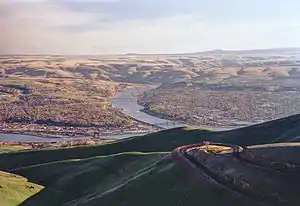Inland Northwest
The Inland Northwest, historically and alternatively known as the Inland Empire, is a region of the American Northwest centered on the Greater Spokane Area,[1] that includes all of Eastern Washington and North Idaho. Northeastern Oregon and Western Montana are also sometimes considered part of the Inland Northwest, but Western Montana generally is not considered part of the Inland Empire. Under some definitions, the Inland Empire also excludes Central Washington or Idaho County, Idaho.

As of 2016, the U.S. Census Bureau estimated the combined population of eastern Washington and north Idaho alone to be 2,240,645, comparable to that of New Mexico. Its Canadian counterpart, north of the border, is the British Columbia Interior. Significant urban centers include the Spokane–Coeur d'Alene area and the Tri-Cities.
There have been several proposals to politically unite the Inland Northwest. In the mid and late 1860s, there was a proposal centered on Lewiston in northern Idaho for a Columbia Territory to be formed in the region from parts of what is now eastern Washington, northern Idaho and western Montana.[2] In 1901, another proposal was made, this time to combine the Idaho Panhandle with Eastern Washington to create the State of Lincoln. A third proposal was popularized in the late 1920s to consist of eastern Washington, northern Idaho and western Montana to the Continental Divide.
Counties
- Washington
- Adams, Asotin, Benton, Chelan, Columbia, Douglas, Ferry, Franklin, Garfield, Grant, Kittitas, Klickitat, Lincoln, Okanogan, Pend Oreille, Spokane, Stevens, Walla Walla, Whitman, and Yakima
- Idaho
- Benewah, Bonner, Boundary, Clearwater, Idaho, Kootenai, Latah, Lewis, Nez Perce, and Shoshone
Oregon (often included)
Montana (sometimes included; never included as part of the Inland Empire)
Geography
The region is bounded by the Cascade Mountains on the west and the Rocky Mountains (following the spine of the remote and rugged Cabinet Mountains) on the east, the Blue Mountains of Oregon and foothills of the Wallowa Mountains to the south, southeast, and encompasses the Columbia river basin (or Columbia Plateau). Between the three mountain ranges are large, sweeping areas of semi-arid steppe, part of which has been irrigated due to the Columbia Basin Project, resulting in expansive farmland in central Washington. The Palouse, original home of the Appaloosa, is another major agricultural region located in the gently rolling hills of southeastern Washington and extending into Idaho. In northern Idaho, the Silver Valley is a mineral-rich region of the Coeur d'Alene Mountains noted for its mining heritage, dating back to the 1880s.
Spokane, the region's largest city, is located near where the arid, and largely unforested Columbia plateau meets the lush forests of the Selkirk Mountains. The urban area stretches east into Idaho along the I-90 corridor through the Spokane River valley across the border of Idaho into the cities of Post Falls and Coeur d'Alene on the north bank of Lake Coeur d'Alene. The Northeastern Washington and Northern Idaho portion of the Inland Empire are mountainous and forested, and the crest of the Bitterroot Range of the Rocky Mountains forms part of the eastern boundary of the Inland Empire region, while the Columbia River forms a significant part of its southern boundary.
Gallery
 Spokane
Spokane Hills near West Richland, Washington
Hills near West Richland, Washington
 Coeur d'Alene
Coeur d'Alene Hangman or Latah Creek, a historical site
Hangman or Latah Creek, a historical site Lake Pend Oreille, 1,150 ft (350 m) deep
Lake Pend Oreille, 1,150 ft (350 m) deep View from north of Lewiston, Idaho and Clarkston, Washington
View from north of Lewiston, Idaho and Clarkston, Washington Oregon Butte in the Wenaha–Tucannon Wilderness
Oregon Butte in the Wenaha–Tucannon Wilderness Palouse Canyon
Palouse Canyon



 The Palouse from Steptoe Butte
The Palouse from Steptoe Butte Interpretive sign on summit of Steptoe Butte
Interpretive sign on summit of Steptoe Butte
Climate
The Washington side is generally semi-arid, while the Idaho side experiences a mostly dry summer continental climate.
Largest cities by population
- Spokane, Washington (pop. 217,300)
- Spokane Valley, Washington (pop. 94,919)
- Yakima, Washington (pop. 93,701)
- Kennewick, Washington (pop. 80,280)
- *Missoula, Montana (pop. 73,340)
- Pasco, Washington (pop. 71,680)
- Richland, Washington (pop. 54,150)
- Coeur d'Alene, Idaho (pop. 52,593)
- Post Falls, Idaho (pop. 34,371)
- Wenatchee, Washington (pop. 34,060)
- Walla Walla, Washington (pop. 33,840)
- Lewiston, Idaho (pop. 33,334)
- Pullman, Washington (pop. 32,280)
- Moscow, Idaho (pop. 25,984)
- *Kalispell, Montana (pop. 23,212)
- Moses Lake, Washington (pop. 22,720)
- Ellensburg, Washington (pop. 19,550)
- *Hermiston, Oregon (pop. 17,985)
- *Pendleton, Oregon (pop. 16,890)
- Sunnyside, Washington (pop. 16,640)
- Hayden, Idaho (pop. 14,760)
- West Richland, Washington (pop. 14,660)
- East Wenatchee, Washington (pop. 13,600)
- *La Grande, Oregon (pop. 13,245)
- Cheney, Washington (pop. 11,880)
- Grandview, Washington (pop. 11,170)
*Sometimes considered to be in the region
See also
References
- Stratton, David H., ed. (2004), Spokane & the Inland Empire: An Interior Pacific Northwest Anthology, Washington State University, ISBN 0-87422-277-X
- Merle W. Wells. "Territorial Government in the Inland Empire: The Movement to Create Columbia Territory, 1864-69." The Pacific Northwest Quarterly. Vol. 44, No. 2 (April 1953), pp. 80-87.

